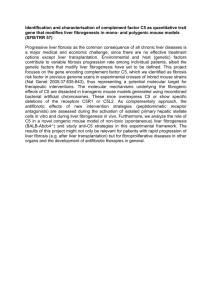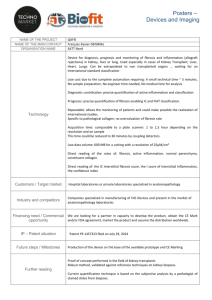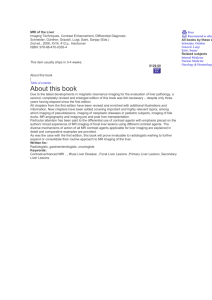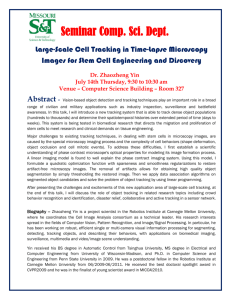Ex vivo imaging and quantification of liver fibrosis using Please share
advertisement
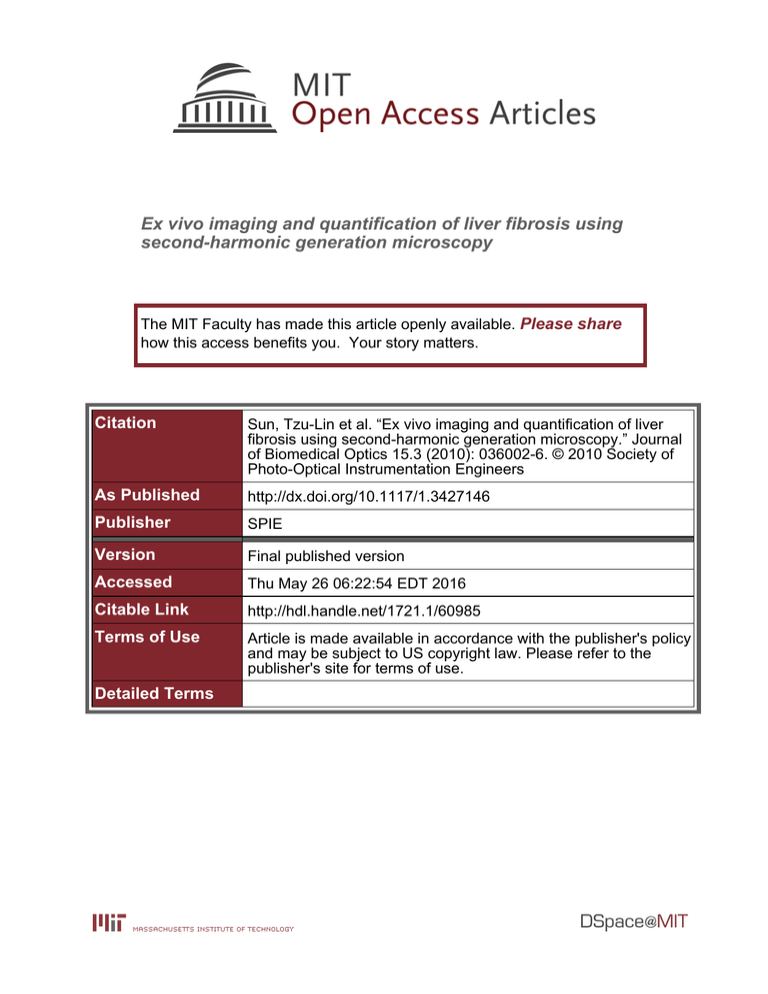
Ex vivo imaging and quantification of liver fibrosis using second-harmonic generation microscopy The MIT Faculty has made this article openly available. Please share how this access benefits you. Your story matters. Citation Sun, Tzu-Lin et al. “Ex vivo imaging and quantification of liver fibrosis using second-harmonic generation microscopy.” Journal of Biomedical Optics 15.3 (2010): 036002-6. © 2010 Society of Photo-Optical Instrumentation Engineers As Published http://dx.doi.org/10.1117/1.3427146 Publisher SPIE Version Final published version Accessed Thu May 26 06:22:54 EDT 2016 Citable Link http://hdl.handle.net/1721.1/60985 Terms of Use Article is made available in accordance with the publisher's policy and may be subject to US copyright law. Please refer to the publisher's site for terms of use. Detailed Terms Journal of Biomedical Optics 15共3兲, 036002 共May/June 2010兲 Ex vivo imaging and quantification of liver fibrosis using second-harmonic generation microscopy Hsuan-Shu Lee† Tzu-Lin Sun* Yuan Liu* Ming-Chin Sung National Taiwan University Institute of Biotechnology and National Taiwan University Hospital Department of Internal Medicine and National Taiwan University College of Medicine Taipei, 100 Taiwan National Taiwan University Department of Physics Taipei, 10617 Taiwan Hsiao-Ching Chen National Taiwan University Hospital Department of Internal Medicine Taipei, 100 Taiwan and National Taiwan University College of Medicine Taipei, 100 Taiwan Chen-Yuan Dong† National Taiwan University Department of Physics and Center for Quantum Science and Engineering and Division of Genomic Medicine Research Center for Medical Excellence Biomedical Molecular Imaging Core Taipei, 100 Taiwan Chun-Hui Yang Vladimir Hovhannisyan National Taiwan University Department of Physics Taipei, 10617 Taiwan Abstract. Conventionally, liver fibrosis is diagnosed using histopathological techniques. The traditional method is time-consuming in that the specimen preparation procedure requires sample fixation, slicing, and labeling. Our goal is to apply multiphoton microscopy to efficiently image and quantitatively analyze liver fibrosis specimens bypassing steps required in histological preparation. In this work, the combined imaging modality of multiphoton autofluorescence 共MAF兲 and second-harmonic generation 共SHG兲 was used for the qualitative imaging of liver fibrosis of different METAVIR grades under label-free, ex vivo conditions. We found that while MAF is effective in identifying cellular architecture in the liver specimens, it is the spectrally distinct SHG signal that allows the characterization of the extent of fibrosis. We found that qualitative SHG imaging can be used for the effective identification of the associated features of liver fibrosis specimens graded METAVIR 0 to 4. In addition, we attempted to associate quantitative SHG signal to the different METAVIR grades and found that an objective determination of the extent of disease progression can be made. Our approach demonstrates the potential of using multiphoton imaging in rapid classification of ex vivo liver fibrosis in the clinical setting and investigation of liver fibrosis–associated physiopathology in animal models in vivo. © 2010 Society of Photo-Optical Wei-Chou Lin Yung-Ming Jeng National Taiwan University Hospital and National Taiwan University College of Medicine Department of Pathology Taipei, 10002 Taiwan Wei-Liang Chen National Taiwan University Department of Physics Taipei, 10617 Taiwan Ling-Ling Chiou Guan-Tarn Huang National Taiwan University Hospital Department of Internal Medicine Taipei, 100 Taiwan and National Taiwan University College of Medicine Taipei, 100 Taiwan Ki-Hean Kim Peter T. C. So Massachusetts Institute of Technology Department of Mechanical Engineering and Division of Bioengineering Cambridge, Massachusetts 02139 Instrumentation Engineers. 关DOI: 10.1117/1.3427146兴 Keywords: liver fibrosis; METAVIR; multiphoton autofluorescence; second-harmonic generation. Yang-Fang Chen National Taiwan University Department of Physics Taipei, 10617 Taiwan Paper 09504RR received Nov. 12, 2009; revised manuscript received Feb. 25, 2010; accepted for publication Mar. 9, 2010; published online Jun. 30, 2010. 1 *These authors contributed equally to this work. † Address all correspondence to: Chen-Yuan Dong, Tel: 886-2-3366-5155; Fax: 886-2-2363-9984; E-mail: cydong@phys.ntu.edu.tw and Hsuan-Shu Lee, Tel: 886-2-3366-6007; Fax: 886-2-3366-6001; E-mail: benlee@ntu.edu.tw. Journal of Biomedical Optics microscopy; Introduction Conventional histopathology is regarded as the gold standard in diagnosing tissue pathologies such as liver fibrosis. In this 1083-3668/2010/15共3兲/036002/6/$25.00 © 2010 SPIE 036002-1 May/June 2010 Downloaded from SPIE Digital Library on 31 Jan 2011 to 18.51.3.135. Terms of Use: http://spiedl.org/terms 쎲 Vol. 15共3兲 Sun et al.: Ex vivo imaging and quantification of liver fibrosis… approach, sample preparation procedures are time-consuming in that the specimens required fixation, sectioning, and labeling. In histopathological examination, the extent of liver fibrosis is examined by experienced pathologists using biopsy specimens. Frequently, the METAVIR scoring system is used for the semiquantitative determination of biopsied liver fibrosis specimens. This system classifies liver fibrosis into five categories 共grades 0 to 4兲 according to the morphological features of collagen fiber formation within the biopsied specimens. Specifically, the key morphological features of no fibrosis, portal fibrosis without septa, fibrosis with few septa, numerous septa without cirrhosis, and cirrhosis are respectively associated with METAVIR scores of 0 to 4 Ref. 1. While the METAVIR system is heavily used in the clinical setting, the qualitative nature of the grading process prevents a more precise and quantitative determination of the extent of liver fibrosis to be achieved. Furthermore, the histopathological method is limiting in that the sample preparation procedures can be time-consuming and in that this approach prevents subsequent tissue dynamics to be followed in vivo. In recent years, multiphoton microscopy emerged as a promising technique for the qualitative imaging and quantitative characterization of many tissues. Key advantages such as high axial-depth discrimination, reduced photodamage, and enhanced penetration depths enable this technique to be the preferred tool for minimally invasive imaging.2,3 In addition to fluorescence excitation, the nonlinear polarization effect of second-harmonic generation 共SHG兲 has also been demonstrated to be useful for imaging and characterizing abnormalities of the extracellular collagen matrix.4–8 To understand the SHG phenomenon, consider the polarization P̃共t兲 of a material that depends on the susceptibility tensor and is a polynomial function of the applied external electric field Ẽ共t兲: P̃共t兲 = 0关共1兲Ẽ共t兲 + 共2兲Ẽ2共t兲 + 共3兲Ẽ3共t兲 + ¯ 兴 . 共1兲 In the case of collagen fibers, the inherent noncentrosymmetric structure gives rise to a nonvanishing second-order susceptibility tensor 共2兲 that, when coupled to the external electric field, generates a nonlinear optical signal at exactly half the wavelength of the excitation source. Second-harmonic generation 共SHG兲 signal has been demonstrated to be effective for the label-free 共in vivo or ex vivo兲 imaging of tissues such as collagen and muscle fibers.5,9–11 For pathological studies, earlier studies have demonstrated that multiphoton autofluorescence 共MAF兲 and SHG imaging are effective in diagnosing pathological tissues such as skin aging, basal cell carcinoma, keratoconus, atherosclerosis, osteogenesis imperfecta, and muscular diseases.6,7,12–17 Similar studies have been performed for the diagnosis of liver fibrosis, in a forward SHG detection configuration.5,18 To further demonstrate the clinical potential of such a method, we investigated frozen sections of human liver fibrosis tissues using backward-detected MAF and SHG signal. The ability for in vivo liver imaging using such a backward-detection setup has been demonstrated in our previous work.19–21 In addition, the use of human tissue allows us to compare the quantitative analysis of the acquired images with the METAVIR scoring system of human liver fibrosis specimens. Journal of Biomedical Optics Our aim is to show that the intrinsic multiphoton signatures from the tissue specimens can identify features useful for the qualitative evaluation of disease progression and to provide a quantitative link between the SHG signal and liver fibrosis tissues of different METAVIR grades. 2 Materials and Methods 2.1 Multiphoton Imaging System The multiphoton imaging microscope used in this study is similar to one previously described.22 In short, the 780-nm output of a femtosecond, titanium-sapphire laser 共Tsunami, Spectra Physics, Mountain View, California兲 pumped by a diode-pumped, solid-state laser 共Millennia X, Spectra Physics兲 was used for excitation. The excitation source was guided toward a modified upright microscope 共E800, Nikon, Tokyo, Japan兲 by a set of x-y galvanometer-driven, scanning mirrors 共model number 6210, Cambridge Technology, Cambridge, Massachusetts兲. Upon entering the microscope, the laser was beam-expanded to ensure overfilling of the objective’s back aperture. The expanded laser beam is reflected into the high numerical aperture focusing objective by the main dichroic mirror 共435DCXR, Chroma Technology, Rockingham, Vermont兲. For high-resolution imaging, a high-numericalaperture, oil-immersion objective 共Nikon S Fluor 40⫻ / NA 1.3兲 was used. Otherwise, an oil-immersion objective 共Nikon Plan Fluor 20⫻ / NA 0.75 MI兲 was used to acquire large-area images for SHG signal quantification. The MAF and SHG signals produced at the focal spot were collected in the epiilluminated geometry and separated by a secondary dichroic and additional bandpass filters 共E435LP 700SP, HQ 390/20, Chroma Technology兲 for the collection and isolation of broadband autofluorescence 共435 to 700 nm兲 and SHG 共380 to 400 nm兲 signals, respectively. Single-photon counting photomultiplier tubes 共R7400P, Hamamatsu, Hamamatsu City, Japan兲 and home-built discriminators were used for the detection and processing of the signal photons. For the acquisition of large-area, multiphoton images, a sample translation stage 共H101, Prior Scientific, Cambridge, UK兲 was used to translate the specimen after each small-area optical scan. The individual small images 110⫻ 110 m2 in area 共S Fluor 40 ⫻ objective, Nikon兲 and 220⫻ 220 m2 in area 共Plan Fluor 20⫻ objective, Nikon兲 are then assembled to form a largearea image 1980⫻ 1540 m2 共S Fluor 40⫻ objective兲 for qualitative multiphoton imaging and 3300⫻ 3300 m2 共Plan Fluor 20⫻ objective兲 for quantitative SHG measurement. In this manner, high resolution, large-area view, and quantification of the severity of the tissue fibrosis can be achieved. 2.2 Preparation of Frozen Specimens In order to demonstrate the imaging capabilities of multiphoton microscopy in label-free imaging of liver fibrosis specimens, frozen tissues were used. One tissue block from each patient was frozen at −80 ° C after embedding with optical cutting temperature compound. Each frozen tissue block was sectioned into specimens approximately 10 m in thickness. One of two adjacent sections was used for multiphoton imaging and the other sample was stained with Masson’s trichrome labeling for collagen-specific, histological comparison to the multiphoton results. In addition, since the intensity profile of 036002-2 May/June 2010 Downloaded from SPIE Digital Library on 31 Jan 2011 to 18.51.3.135. Terms of Use: http://spiedl.org/terms 쎲 Vol. 15共3兲 Sun et al.: Ex vivo imaging and quantification of liver fibrosis… the multiphoton signals was not uniform across the imaged area, multiphoton images of the liver fibrosis specimens were corrected using an image field flatness correction algorithm developed in our laboratory.23 2.3 Label-Free Optical Biopsy and Quantification of Liver Fibrosis Following preparation of the liver fibrosis specimens as described earlier, we performed MAF and SHG imaging of liver fibrosis specimens that have been histologically graded using the METAVIR system 共scores 0 to 4兲, and the results are compared to the histological images from the same patient. The severity of liver fibrosis is highly correlated with the growth of collagen fibers. Therefore, to quantify liver fibrosis of the imaged specimens, we analyzed the collagen content in the fibrotic tissues. The previous work of Sun et al. mentions that the intensity of SHG signal from aggregated and distributed collagen can be used to examine the extent of liver fibrosis in animal specimens.5 In this work, we apply the aggregated and total collagen 共aggregated and dispersed collagen兲 fibers as indicators for grading human liver fibrosis. The ratio of the total collagen area to total specimen area 共TC-ratio兲 and area of aggregated collagen to total specimen area 共AC-ratio兲 are determined. For the analysis of total collagen area, the pixel numbers of the SHG image 关Fig. 1共a兲兴 having intensity above the threshold value are counted as the total collagen area. Since the intensity and distribution of aggregated collagen 共black arrow兲 is much higher and denser than those of dispersed collagen 共white arrow兲, we applied a 3-pixel-wide boxcar average to smooth out the dispersed collagen in the SHG images. The mean intensity of one random-selected region without aggregated collagen in the smoothed SHG image was measured as the threshold value. Then, the aggregated collagen area was isolated from the smoothed SHG image by setting this threshold value. The pixel numbers above the threshold value represent the aggregated collagen area. 3 Results 3.1 Optical Biopsy of Liver Fibrosis The METAVIR scoring of liver fibrosis is determined by the fibrous expansion of the portal tract.1 The portal tract is a component of the hepatic lobule and is composed of the hepatic artery, hepatic portal vein, bile duct, and lymphatic vessels. Shown in Fig. 2 and Fig. 3 are representative MAF and SHG images of liver fibrosis tissues that show morphological features corresponding to METAVIR grades 0 to 4, respectively. Histological images obtained using Masson’s trichrome stains are also shown for comparison. Since we used frozen sections for multiphoton imaging, histological comparison is made by identifying similar features in Masson’s trichrome– prepared specimens from an adjacent section of the tissue specimen. Shown in Fig. 2共a兲 is the large-area, multiphoton image of a grade 0 METAVIR tissue, and the histological comparison is shown in Fig. 2共b兲. The selected region of interest 共dashed frame兲 is shown in Fig. 2共c兲 as a magnified view of the portal tract surrounded by second-harmonic generating collagen fibers 共yellow arrow兲. In addition, since hepatocyte nuclei 共white arrow兲 lack autofluorescence, individual hepatocytes Journal of Biomedical Optics Fig. 1 共a兲 SHG imaging shows the distinction between aggregated 共black arrow兲 and dispersed collagen 共white arrow兲. Scale bar is 100 m. 共b兲 Relationship between AC-ratios, TC-ratios, and METAVIR grades. The specimen numbers from METAVIR scores of 0 to 4 are 5, 3, 5, 7, and 5, respectively. *; Both AC-ratios and TC-ratios of METAVIR score 0; 1 and 2 have significant difference from those of METAVIR score 4. can be identified by round regions void of MAF surrounded by autofluorescent cytoplasm 共color online only兲. Similar features are found in the histological image 关Fig. 2共d兲兴. Note that in the Masson’s trichrome–prepared specimen, the blue pseudo color represents the collagen fibers 共yellow arrow兲, purple is the cytoplasm, and dark spots 共white arrow兲 indicate positions of hepatocyte nuclei 共color online only兲. Therefore, for collagen fibrosis identification, imaging with the spectrally separated MAF and SHG signals can provide high-contrast, label-free images comparable to that provided by conventional histological examination. In comparison, a multiphoton image of a METAVIR grade 1 specimen is shown in Fig. 3共1a兲. Note that the extension of liver fibrosis 共yellow arrow兲 from a portal tract is clearly visible. Similar features can be observed in the histological comparison in Fig. 3共1b兲; 共arrow兲. For imaging of a METAVIR grade 2 specimen 关Fig. 3共2兲兴, the formation of mild fibrotic bridging between two portal tracts, the hallmark of the METAVIR grade 2 pathology, can be easily identified 关Fig. 3共2a兲兴. Once again, histological compari- 036002-3 May/June 2010 Downloaded from SPIE Digital Library on 31 Jan 2011 to 18.51.3.135. Terms of Use: http://spiedl.org/terms 쎲 Vol. 15共3兲 Sun et al.: Ex vivo imaging and quantification of liver fibrosis… Fig. 2 Imaging of METAVIR grade 0 tissue by 共a兲 multiphoton microscopy and 共b兲 histological comparison. The portal tract surrounded by SHG collagen fibers 共enclosed region兲 can be delineated. Magnified images of the selected region of interest under 共c兲 multiphoton and 共d兲 histological examination. The yellow arrow indicates the normal fibrous tissue of the portal tract, and the white arrow indicates the hepatocyte nucleus. Scale bar is 200 m. 共Color online only.兲 son of the METAVIR grade 2 tissue with the multiphoton results identifies similar morphological features. In multiphoton imaging of a METAVIR grade 3 specimen 关Fig. 3共3a兲兴, marked bridging fibrosis showing thick fibrotic bands is evident 共dashed line兲. The same feature can be seen in the histological comparison 关Fig. 3共3b兲兴. Last, for imaging of the representative grade 4 METAVIR tissue 关Fig. 3共4兲兴, the multiphoton imaging modality and the histological comparison show the enclosing of fibrotic collagen tissues and the formation of the cirrhotic nodule. The results of liver fibrosis quantification analysis show that the TC-ratio and AC-ratio increase with the METAVIR scores 关Fig. 1共b兲兴. The relationship between METAVIR grades and the fibrotic collagen content is summarized in Table 1. Both Fig. 1共b兲 and Table 1 show that the growth of fibrotic collagen in human liver increases with the severity of the METAVIR grades and that the increases of AC- and TC-ratios are nonlinear with METAVIR scores. For example, the ACratio increased threefold between METAVIR 3 and 0 specimens, while the same ratio increased by 5.71-fold between Journal of Biomedical Optics Fig. 3 共1a兲 to 共4a兲 Multiphoton images of METAVIR grades 1 to 4 tissue, respectively. 共1b兲 to 共4b兲 The corresponding histological comparison for the images shown in 共a兲. In the METAVIR grade 1 tissue, fibrotic collagen emanating from the portal tract 共enclosed region兲 starts to appear, while in the METAVIR grade 2 tissue, mild bridging fibrosis is evident. In the METAVIR grade 3 tissue, marked bridging fibrosis 共dashed lines兲 between adjacent portal tracks is visible, and in the METAVIR grade 4 tissue, formation of a cirrhotic nodule is evident. All scale bars are 200 m. METAVIR 4 and 0 specimens. The statistical significance of the quantification of liver fibrosis was assessed by a one-way ANOVA analysis of variance and subsequent post hoc test using Bonferroni’s Multiple Comparison Test. With P ⬍ 0.05 considered to be statistically significant, our analysis showed that both AC- and TC-ratios of METAVIR scores 0, 1, and 2 are significantly different from those of METAVIR score 4. Although the AC- and TC-ratios show increasing trends from METAVIR scores 0 to 3, the ratios cannot statistically differentiate between samples with those scores. 4 Conclusion In this work, we have demonstrated the application of multiphoton and second-harmonic generation microscopy for the label-free imaging and diagnosis of ex vivo liver fibrosis specimens with METAVIR grades of 0 to 4. Key morphological features of differently graded liver fibrosis can be identified without extrinsic labeling. In addition, we showed that the increase of fibrotic collagen is nonlinear with the 036002-4 May/June 2010 Downloaded from SPIE Digital Library on 31 Jan 2011 to 18.51.3.135. Terms of Use: http://spiedl.org/terms 쎲 Vol. 15共3兲 Sun et al.: Ex vivo imaging and quantification of liver fibrosis… Table 1 Relationship between differently graded METAVIR liver fibrosis specimens, TC-ratios, and ACratios. METAVIR score 0 1 2 3 4 Specimen number 5 3 5 7 5 TC-ratio 0.217 0.242 0.269 0.310 0.427 SD 共TC兲 0.062 0.045 0.078 0.042 0.126 AC-ratio 0.021 0.024 0.039 0.063 0.120 SD 共AC兲 0.013 0.015 0.027 0.018 0.070 METAVIR grades. Clinically, our method can be used as a rapid, label-free, optical biopsy tool for diagnosing liver fibrosis specimens without histological preparations such as the use of Masson’s trichrome staining. The spectrally distinct MAF and SHG signals can provide high-contrast tissue characterization. Furthermore, SHG signal analysis can be used to quantify the amount of fibrotic collagen and can provide an objective determination of collagen content in liver fibrosis tissues. From the result of the statistical analysis, our quantification approach could be used to discriminate normal and METAVIR score 4 liver fibrosis tissues. Further discrimination between tissues with METAVIR scores 1, 2, and 3 would likely require morphometric analysis in addition to SHG intensity analysis. Last, since multiphoton microscopy has been demonstrated to be feasible in the in vivo investigation of liver disease in animal models,19,20 additional development using endoscopic techniques would enable multiphoton microscopy to become a real-time diagnostic tool for the clinical evaluation of liver fibrosis.24 Acknowledgments This project was supported by the National Science Council 共NSC兲 Grant No. NSC 98-2112-M-002-008-MY3 in Taiwan and was completed in the Optical Molecular Imaging Microscopy Core Facility 共A5兲 of NRPGM. References 1. T. Poynard, P. Bedossa, and P. Opolon, “Natural history of liver fibrosis progression in patients with chronic hepatitis C. The OBSVIRC, METAVIR, CLINIVIR, and DOSVIRC groups,” Lancet 349共9055兲, 825–832 共1997兲. 2. W. Denk, J. H. Strickler, and W. W. Webb, “2-photon laser scanning fluorescence microscopy,” Science 248共4951兲, 73–76 共1990兲. 3. P. T. C. So, C. Y. Dong, B. R. Masters, and K. M. Berland, “Twophoton excitation fluorescence microscopy,” Annu. Rev. Biomed. Eng. 2, 399–429 共2000兲. 4. P. J. Su, W. L. Chen, J. B. Hong, T. H. Li, R. J. Wu, C. K. Chou, S. J. Chen, C. Hu, S. J. Lin, and C. Y. Dong, “Discrimination of collagen in normal and pathological skin dermis through second-order susceptibility microscopy,” Opt. Express 17共13兲, 11161–11171 共2009兲. 5. W. Sun, S. Chang, D. C. Tai, N. Tan, G. Xiao, H. Tang, and H. Yu, “Nonlinear optical microscopy: use of second-harmonic generation and two-photon microscopy for automated quantitative liver fibrosis studies,” J. Biomed. Opt. 13共6兲, 064010 共2008兲. 6. S. J. Lin, R. J. Wu, H. Y. Tan, W. Lo, W. C. Lin, T. H. Young, C. J. Hsu, J. S. Chen, S. H. Jee, and C. Y. Dong, “Evaluating cutaneous photoaging by use of multiphoton fluorescence and second-harmonic generation microscopy,” Opt. Lett. 30共17兲, 2275–2277 共2005兲. Journal of Biomedical Optics 7. M. J. Koehler, K. Konig, P. Elsner, R. Buckle, and M. Kaatz, “In vivo assessment of human skin aging by multiphoton laser scanning tomography,” Opt. Lett. 31共19兲, 2879–2881 共2006兲. 8. K. Konig, “Clinical multiphoton tomography,” J. Biophotonics 1共1兲, 13–23 共2008兲. 9. P. J. Campagnola and L. M. Loew, “Second-harmonic imaging microscopy for visualizing biomolecular arrays in cells, tissues and organisms,” Nat. Biotechnol. 21共11兲, 1356–1360 共2003兲. 10. W. R. Zipfel, R. M. Williams, and W. W. Webb, “Nonlinear magic: multiphoton microscopy in the biosciences,” Nat. Biotechnol. 21共11兲, 1369–1377 共2003兲. 11. A. Zoumi, A. Yeh, and B. J. Tromberg, “Imaging cells and extracellular matrix in vivo by using second-harmonic generation and twophoton excited fluorescence,” Proc. Natl. Acad. Sci. U.S.A. 99共17兲, 11014–11019 共2002兲. 12. S. J. Lin, S. H. Jee, C. J. Kuo, R. J. Wu, W. C. Lin, J. S. Chen, Y. H. Liao, C. J. Hsu, T. F. Tsai, Y. F. Chen, and C. Y. Dong, “Discrimination of basal cell carcinoma from normal dermal stroma by quantitative multiphoton imaging,” Opt. Lett. 31共18兲, 2756–2758 共2006兲. 13. H. Y. Tan, Y. Sun, W. Lo, S. J. Lin, C. H. Hsiao, Y. F. Chen, S. C. M. Huang, W. C. Lin, S. H. Jee, H. S. Yu, and C. Y. Dong, “Multiphoton fluorescence and second-harmonic generation imaging of the structural alterations in keratoconus ex vivo,” Invest. Ophthalmol. Visual Sci. 47共12兲, 5251–5259 共2006兲. 14. T. T. Le, I. M. Langohr, M. J. Locker, M. Sturek, and J. X. Cheng, “Label-free molecular imaging of atherosclerotic lesions using multimodal nonlinear optical microscopy,” J. Biomed. Opt. 12共5兲, 054007 共2007兲. 15. R. LaComb, O. Nadiarnykh, and P. J. Campagnola, “Quantitative second-harmonic generation imaging of the diseased state osteogenesis imperfecta: Experiment and simulation,” Biophys. J. 94共11兲, 4504–4514 共2008兲. 16. S. V. Plotnikov, A. M. Kenny, S. J. Walsh, B. Zubrowski, C. Joseph, V. L. Scranton, G. A. Kuchel, D. Dauser, M. S. Xu, C. C. Pilbeam, D. J. Adams, R. P. Dougherty, P. J. Campagnola, and W. A. Mohler, “Measurement of muscle disease by quantitative second-harmonic generation imaging,” J. Biomed. Opt. 13共4兲, 044018 共2008兲. 17. A. Uchugonova, K. Konig, R. Bueckle, A. Isemann, and G. Tempea, “Targeted transfection of stem cells with sub-20 femtosecond laser pulses,” Opt. Express 16共13兲, 9357–9364 共2008兲. 18. D. C. Tai, N. Tan, S. Xu, C. H. Kang, S. M. Chia, C. L. Cheng, A. Wee, C. L. Wei, A. M. Raja, G. Xiao, S. Chang, J. C. Rajapakse, P. T. So, H. H. Tang, C. S. Chen, and H. Yu, “Fibro-C-Index: comprehensive, morphology-based quantification of liver fibrosis using secondharmonic generation and two-photon microscopy,” J. Biomed. Opt. 14共4兲, 044013 共2009兲. 19. F. C. Li, Y. Liu, G. T. Huang, L. L. Chiou, J. H. Liang, T. L. Sun, C. Y. Dong, and H. S. Lee, “In vivo dynamic metabolic imaging of obstructive cholestasis in mice,” Am. J. Physiol. Gastrointest. Liver Physiol. 296共5兲, G1091–1097 共2009兲. 20. Y. Liu, H. C. Chen, S. M. Yang, T. L. Sun, W. Lo, L. L. Chiou, G. T. Huang, C. Y. Dong, and H. S. Lee, “Visualization of hepatobiliary excretory function by intravital multiphoton microscopy,” J. Biomed. Opt. 12共1兲, 014014 共2007兲. 21. T. L. Sun, Y. Liu, M. C. Sung, H. C. Chen, C. H. Yang, V. Hovhannisyan, W. C. Lin, W. L. Chen, L. L. Chiou, G. T. Huang, K. H. Kim, 036002-5 May/June 2010 Downloaded from SPIE Digital Library on 31 Jan 2011 to 18.51.3.135. Terms of Use: http://spiedl.org/terms 쎲 Vol. 15共3兲 Sun et al.: Ex vivo imaging and quantification of liver fibrosis… P. T. C. So, H. S. Lee, and C. Y. Dong, “Label-free diagnosis of human hepatocellular carcinoma by multiphoton autofluorescence microscopy,” Appl. Phys. Lett. 95共19兲, 193703 共2009兲. 22. H. S. Lee, Y. Liu, H. C. Chen, L. L. Chiou, G. T. Huang, W. Lo, and C. Y. Dong, “Optical biopsy of liver fibrosis by use of multiphoton microscopy,” Opt. Lett. 29共22兲, 2614–2616 共2004兲. 23. V. A. Hovhannisyan, P. J. Su, Y. F. Chen, and C. Y. Dong, “Image Journal of Biomedical Optics heterogeneity correction in large-area, three-dimensional multiphoton microscopy,” Opt. Express 16共7兲, 5107–5117 共2008兲. 24. W. Piyawattanametha, R. P. J. Barretto, T. H. Ko, B. A. Flusberg, E. D. Cocker, H. J. Ra, D. S. Lee, O. Solgaard, and M. J. Schnitzer, “Fast-scanning two-photon fluorescence imaging based on a microelectromechanical systems two-dimensional scanning mirror,” Opt. Lett. 31共13兲, 2018–2020 共2006兲. 036002-6 May/June 2010 Downloaded from SPIE Digital Library on 31 Jan 2011 to 18.51.3.135. Terms of Use: http://spiedl.org/terms 쎲 Vol. 15共3兲
